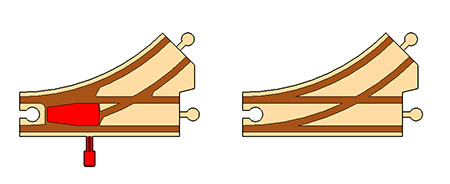The standard BRIO switch is the curved switch track and it comes in two basic configurations: the traditional wooden track types L and M sold in pairs as #33346, and the mechanical switch track types L1 and M1 sold in pairs as #33344. The mechanical switches cost twice as much as the traditional track if bought new, but of course BRIO track can often be had for pennies on the dollar if bought used on eBay making the mechanical switches even more expensive by comparison. There are simply far fewer used mechanical switches for sale, either in lots or by themselves, where as the basic switching track is pretty much everywhere. So why buy mechanical switches when they cost so much more?
Well, the key advantage of a mechanical switch is that it prevents derailments. Unlike a traditional switch track, the mechanical piece guarantees that all the wheels in the carriage will follow the same path, and that all wagons in the train will do the same. With the classic track, some manual guidance is needed to ensure the train goes the correct direction, especially when negotiating the curved portion of the switch.

This is clearly important for battery trains, the whole point of which are to run without needing to be handled. But mechanical switches are useful even for unpowered engines, too. If you want to set up a layout where the default path through the switch is the curved path, not the straight, then a mechanical switch is going to be a lot more convenient and a lot less hassle than a traditional switch.
There are some down sides to mechanical switches, though. First, they are, as mentioned earlier, more expensive and harder to find used. Second, they take up more space. The mechanical actuator sticks out almost 30mm from the side of the track, so you can’t lay the straight edge of a mechanical switch very close to a parallel run of track. And third, you have to be able to reach the actuator to move it.
With some careful planning, though, you can work around all of these. In general, it comes down to the following: use mechanical switches only where they are truly needed, and plan your layout so that there is room for them. In the coming days, I’ll be updating the 2-D SketchUp model file to include the mechanical switch parts to help with that.
Thanks John, interesting article. I tend to use the mechanical switches to take a train off a loop on to another loop&a non mechanical one to let the train rejoin which seems to prevent derailing (although my little boy seems to enjoy doing that on purpose!)
Have you ever bought a remote control switch and if so what do you think? I see them pop up occasionally on ebay but are quite expensive& wondered if they were worth it?
Many thanks, Rob
Yeah, mechanical switches make the most sense when you are heading in the switch direction, as opposed to in the join direction. As long as no one backs up the train, of course. 🙂 I have never bought the remote control switch. Its footprint is rather large which is my first concern (I am guessing it’s a good 40mm in addition to the width of the track itself). My second is the lack of information on how the remote actually works. Does each remote have a selectable channel? Or does one remote control all the switches that are in range? If I can find a deal on one I may pick it up just to see.
The brio remote track has an A as well as B channel.
Also the remote track can be switched by pushing a red button on the yellow plastic part.
It is pretty cool set.
The last one I had was snapped up by a collector in japan.
Hey! So on my own I actually designed and engineered a remote control switch. See my Etsy shop here:
https://www.etsy.com/shop/DadBotsToys
While I also think there is a place for mechanical switches. Particularly for younger children. Older children may enjoy the ability to remote control the switch.
My switch has 3 selectable channels. But you could of course have multiple switches go at the same time on the same channel. The switch does have a decently large footprint currently. I’m considering making a smaller form factor version in the future.